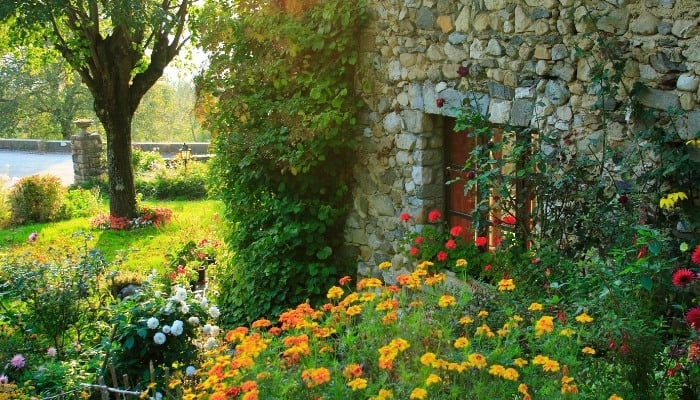France is well-known for its exceptional cuisine and fashionable aesthetic, but it is also renowned for its exquisite array of local flowers.
From daring, passionate colors to delicate hues and textures, each of the following blooms would look très romantique in your garden!
Here are 24 low-maintenance French flowers, their unique meanings, growing tips, and more.
#1. Lavender
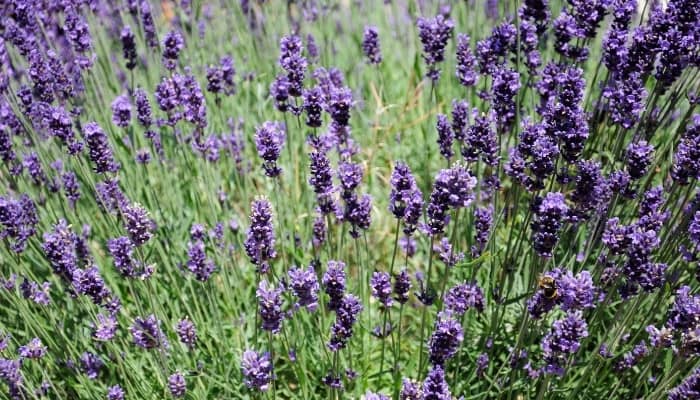
With its rich, heady scent, French lavender has been cultivated by chefs and perfumers for centuries and will thrive when lightly watered to prevent fungal issues.
Lavender is symbolic of purity due to its association with the Virgin Mary, and its historical aromatherapy uses have also led it to signify grace and spirituality.
- Botanical Name: Lavandula stoechas
- Meaning: Purity
- Common Colors: Purple, blue, violet
- Popular Varieties: ‘Hidcote’, dwarf lavender
- Best for Growing Zones: 7-11
- Light Requirements: 6-8 hours full sun
#2. Iris

For centuries, irises were depicted in the ancient Royal Family emblem, causing much debate about France’s true national flower.
Iris’ name originates from the Greek goddess Iris meaning “rainbow,” which is fitting due to its wide color spectrum. Dividing your irises every 3-5 years is recommended to prevent crowding.
- Botanical Name: Iris germanica
- Meaning: Rainbow
- Common Colors: Blue, purple, white, multi
- Popular Varieties: Bearded iris, Dutch iris
- Best for Growing Zones: 5-9
- Light Requirements: 6 hours full sun
#3. Lilies
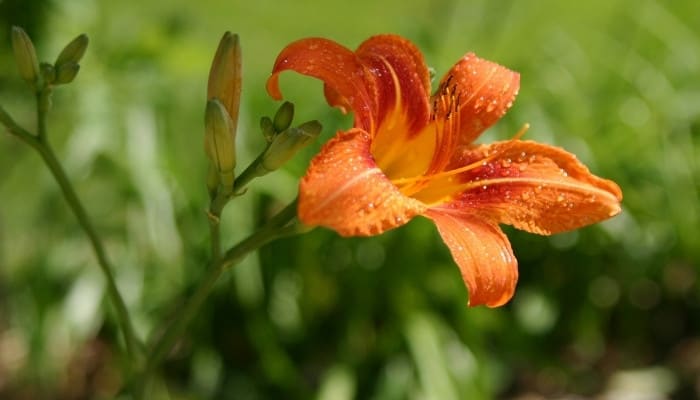
Lilies have long been associated with fertility and prosperity, but they were also famously featured on the French crown and in classical decoration during the monarchy.
The decorative emblem is named the Fluer-de-lis (lily flower).
Lilies only bloom once a year, so enjoy them at their best by planting them in raised beds and peat moss soil to encourage excellent drainage.
- Botanical Name: Lilium
- Meaning: Prosperity
- Common Colors: White, orange, yellow
- Popular Varieties: Madonna lily, tiger lily
- Best for Growing Zones: 6-9
- Light Requirements: 6-8 hours full sun
#4. Poppies
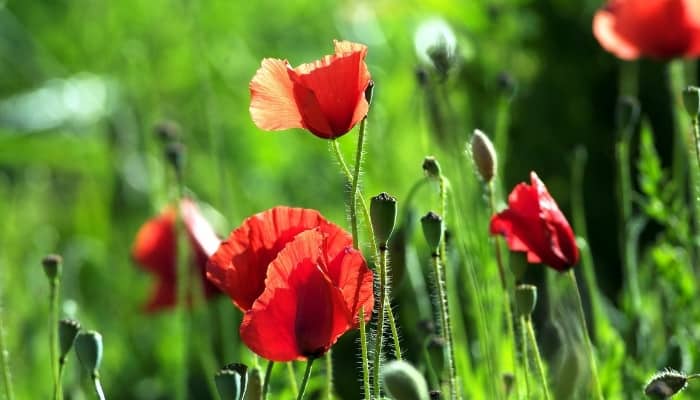
Poppies symbolize remembrance and sacrifice in honor of fallen soldiers during WWI, and the tradition of wearing one was initiated by the French humanitarian Anna A Guérin during her post-war charity work.
Water your garden poppies once weekly to encourage healthy blooms, and maintain a weed-free bed to ensure incoming blooms won’t be competing for nutrients.
- Botanical Name: Papaver spp.
- Meaning: Remembrance
- Common Colors: Red, white, orange
- Popular Varieties: ‘Ladybird’, ‘Bridal Silk’
- Best for Growing Zones: 5-10
- Light Requirements: 6 hours full sun
#5. Gourdon Flowers

These elegant bellflowers grow in the Gourdon region and can be found brimming over walls throughout Paris. They’ll grow best in well-draining soil, so add horticultural grit to the compost.
Also known as Campanula, these drooping flowers historically represent humility in Christianity due to St. Dominic who viewed clothes and shoes as luxuries and hung his head in piousness.
- Botanical Name: Campanula raineri
- Meaning: Humility
- Common Colors: Blue, lavender
- Other Names: Harebell, rampion bellflower
- Best for Growing Zones: 3-7
- Light Requirements: 6-8 hours full sun
#6. Gerbera Daisies
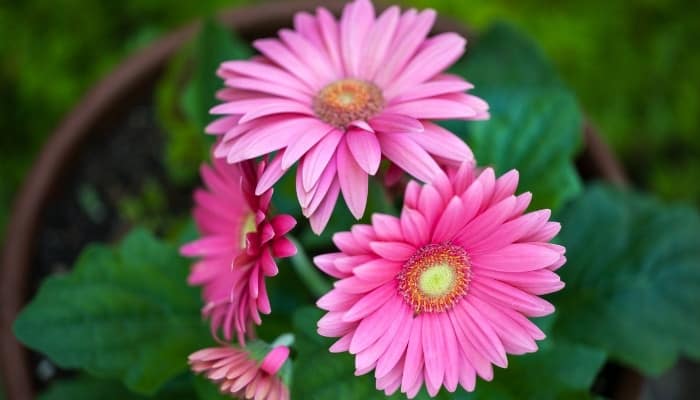
These flamboyant beauties are members of the sunflower family (Asteraceae) and were named by 18th-century botanist Traugott Gerber.
They are prone to disease in crowded conditions, so plant them 12-18 inches apart. (Find more growing tips here.)
Gerbera daisies were thought to have grown in the temple gardens of Ancient Egypt as a sign of sun devotion while Celtic legend equated them with joy in times of hardship.
- Botanical Name: Gerbera jamesonii
- Meaning: Joy
- Common Colors: Pink, yellow, white
- Popular Varieties: ‘Orange Spider’, quilled gerbera
- Best for Growing Zones: 8-11
- Light Requirements: 6 hours full sun
#7. Roses
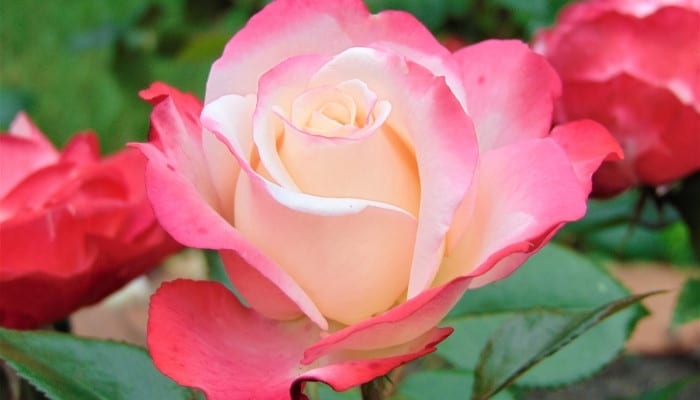
The iconic rose has become a popular fixture in French culture ever since Empress Josephine kept a rose garden consisting of 250 varieties!
They soon became a fashion statement in the French court, symbolizing grace and admiration.
Remove rose suckers (long slender growth at the base of the stem) regularly to maintain healthy blooms.
- Botanical Name: Rosa
- Meaning: Admiration
- Common Colors: Pink, purple, white, red
- Popular Varieties: Tea rose, damask rose
- Best for Growing Zones: 4-8
- Light Requirements: 6 hours full sun
#8. Daffodils
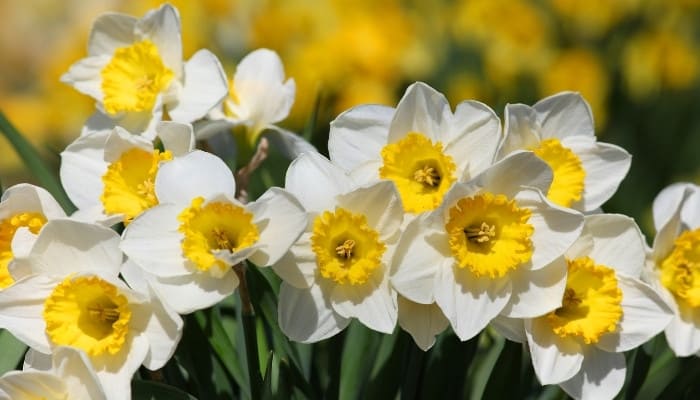
Daffodils are the worldwide sign that spring has sprung, making it a symbol of hope in France and representative of cancer awareness in Britain and the US.
According to Greek legend, daffodils often grow near streams due to the myth of Narcissus, son of the river god who became so enamored by his reflection that he drowned.
- Botanical Name: Narcissus
- Meaning: Hope
- Common Colors: Yellow, orange, white
- Popular Varieties: ‘Spellbinder’, ‘February Gold’
- Best for Growing Zones: 5-9
- Light Requirements: 6 hours full sun
#9. Nasturtium
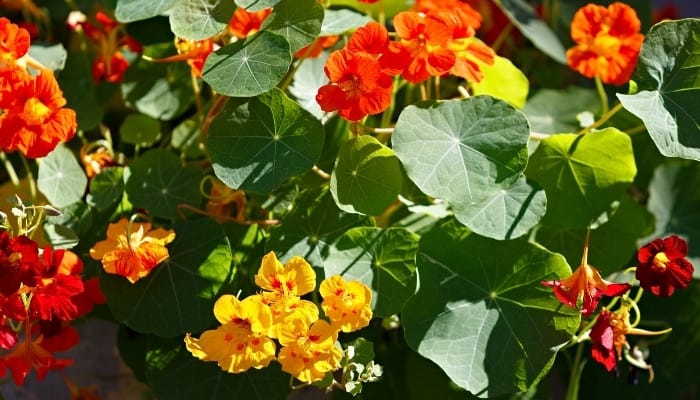
Nasturtium flowers are said to represent loyalty and patriotism and are grown in French restaurants for their use in sweet and savory dishes.
Its name derives from the Latin word ‘nasus’ meaning nose referencing its tart scent! If you grow them for admiration only, keep the soil perpetually moist to encourage gorgeous blooms.
- Botanical Name: Tropaeolum
- Meaning: Loyalty
- Common Colors: Apricot, pink, yellow
- Popular Varieties: Jewel, peach Melba
- Best for Growing Zones: 9-11
- Light Requirements: 6-8 hours full sun
#10. Castile
Found across northern France, these stunning flowers hang in a bell-like pendant of purple and pale pink.
According to The Complete Language of Flowers, the ‘Rose of Castile’ is said to represent bashful love and inspiration.
These flowers are best cared for in a fertile soil medium – nutrient-rich loamy soil is best.
- Botanical Name: Fuchsia ‘Rose of Castile’
- Meaning: Inspiration
- Common Colors: Pale-pink, purple, white
- Popular Varieties: ‘Rose of Castile Improved’
- Best for Growing Zones: 5-9
- Light Requirements: 6 hours full sun/dappled shade
#11. Lily of the Valley
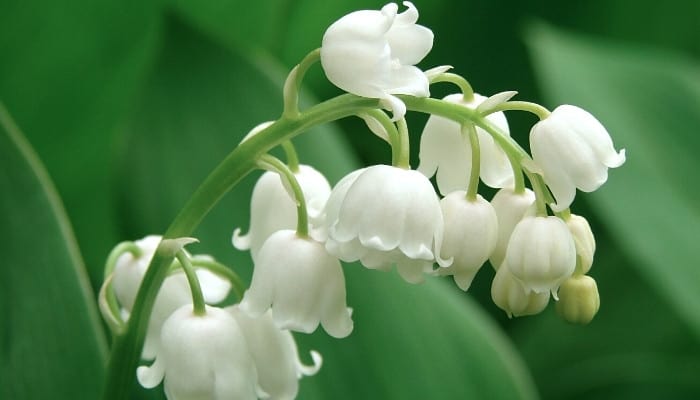
Each year in France on May 1st, lilies of the valley are often exchanged as part of a tradition dating back to 1561 when King Charles IX received them as a token of luck – kickstarting May Day as French citizens know it today.
As this flower has a habit of overtaking its area, plant them in containers or raised beds to prevent them from overwhelming nearby plants.
- Botanical Name: Convallaria majalis
- Meaning: Luck
- Common Colors: White, pink
- Popular Varieties: ‘Rosea’, ‘Fortin’s Giant’
- Best for Growing Zones: 3-8
- Light Requirements: 6-8 hours dappled sunlight
#12. Wisteria

The Wisteria flower has come to symbolize fertility and immortality due to its incredible lifespan – particularly in Japanese culture where a 150-year-old wisteria tree still stands!
You’ll find these stunning climbing vines adorning many a shop front and garden wall in France.
As they are heavy in weight and fast growers, be sure to prune back wilted blooms regularly and remove branches in winter.
- Botanical Name: Wisteria sinensis
- Meaning: Immortality
- Common Colors: Lilac, Pink, Mauve
- Popular Varieties: Silky wisteria, Chinese wisteria
- Best for Growing Zones: 5-9
- Light Requirements: 6 hours full sun
#13. Jasmine
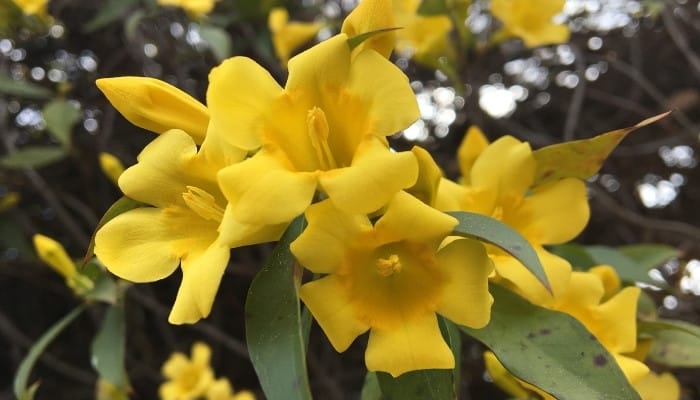
The town of Grasse – the world perfume industry – is teeming with this sweetly scented beauty.
Jasmine derives its name from the Persian name Yasmin meaning “gift from God” and has come to symbolize warmth and positivity.
Boost your jasmine’s flower power with high-potassium fertilizer, like this one, and support their growth with a trellis or fence structure as they have weak trunks.
- Botanical Name: Jasminum
- Meaning: Positivity
- Common Colors: Yellow, white, multi
- Popular Varieties: Winter Jasmine, pink jasmine
- Best for Growing Zones: 6-10
- Light Requirements: 6 hours full sun
#14. Lilacs
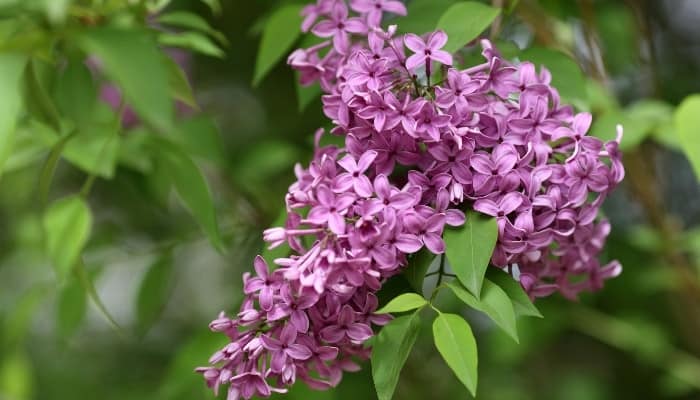
The French flower breeder Victor Lemoine and his wife can be credited with introducing these purple stunners to the country in the 1870s. By 1950, their grandson’s efforts had established over 200 varieties.
Lilacs have long been a symbol of spirituality and tranquility due to their short blooming time encouraging reflection and an appreciation for life’s beauty.
- Botanical Name: Syringa vulgaris
- Meaning: Tranquillity
- Common Colors: Lilac, periwinkle purple
- Popular Varieties: ‘Agincourt Beauty’, ‘Ludwig Spaeth’
- Best for Growing Zones: 4-7
- Light Requirements: 6 hours full sun
#15. Hyacinths
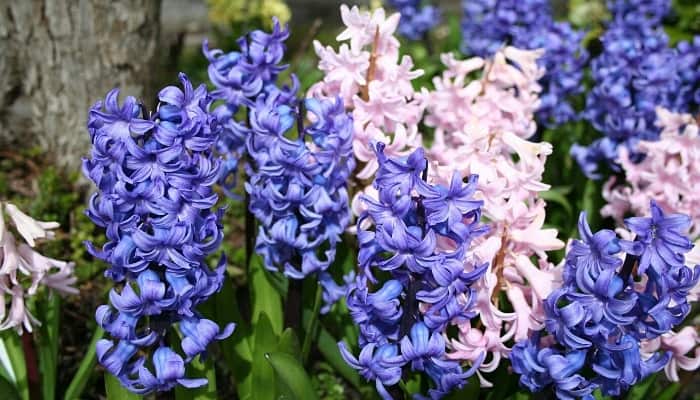
A rainbow bunch of hyacinths may seem romantic, but they are actually associated with jealousy and sorrow due to Greek mythology.
The French would use them for intoxication by spraying a bouquet with poison and placing them in the victim’s boudoir.
Help prevent taller varieties of hyacinth flower from going floppy with support stakes or plant them closely together for natural support.
- Botanical Name: Hyacinthus orientalis
- Meaning: Jealousy
- Common Colors: Blue, violet, pink
- Popular Varieties: Roman hyacinth, ‘Hollyhock’
- Best for Growing Zones: 3-9
- Light Requirements: 6-8 hours sun/partial shade
#16. Tulips
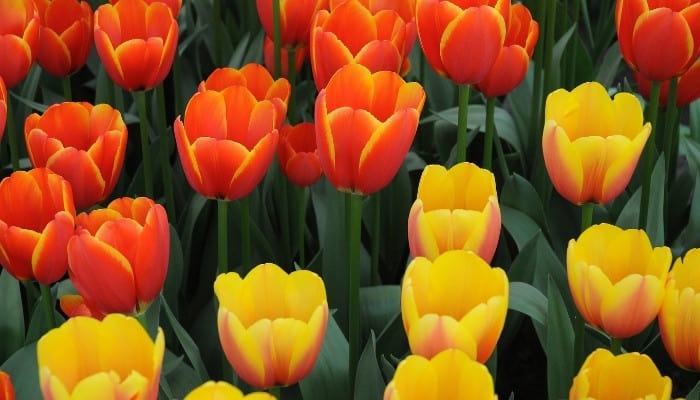
France became gripped by tulip mania in the 1500s after explorer Pierre Belon returned from Turkey with a collection of rouge red tulips.
The country became so besotted that it’s even thought that a miller once traded his livelihood for a single tulip bulb!
Ever since, these flowers have become associated with romance, especially deep-red varieties that signal undying love.
- Botanical Name: Tulipa
- Meaning: Deep love
- Common Colors: Red, peach, yellow
- Popular Varieties: Triumph tulip, ‘Parade’
- Best for Growing Zones: 4-8
- Light Requirements: 6-8 hours full sun
#17. Pansies
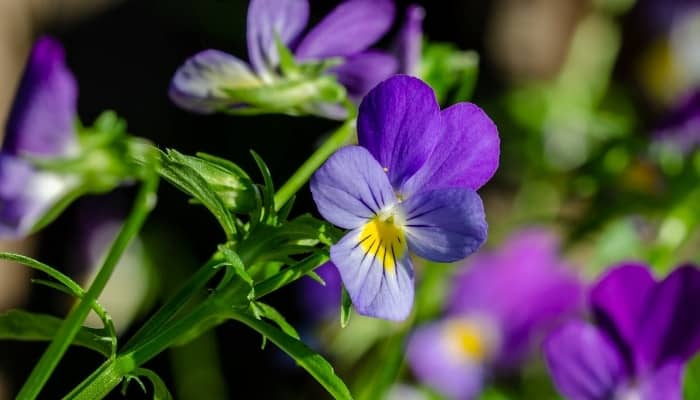
Symbolic of love and fertility, the bright and bold petals of pansy flowers were used by the Ancient Greeks to create “love potions.”
According to herbal folklore, their heart-shaped form meant they could ease a broken heart.
For best results with your garden pansies, make the soil as fertile as possible by adding leaf mold or composted bark before planting.
- Botanical Name: Viola tricolor
- Meaning: Love
- Common Colors: White, violet, gold
- Popular Varieties: Blotch pansy, whiskers pansy
- Best for Growing Zones: 4-8
- Light Requirements: 6 hours full sun
#18. Marigolds
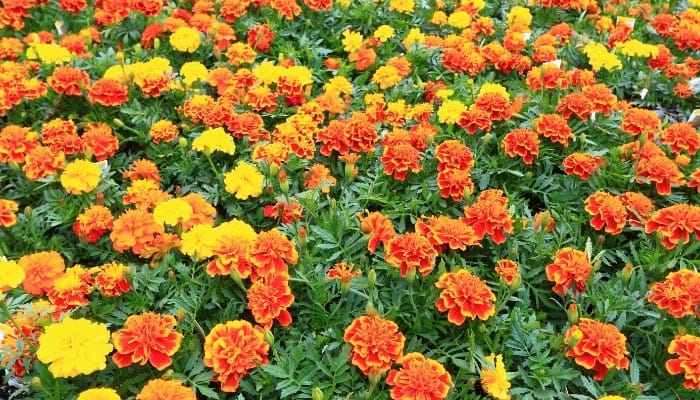
Also known as the “herb of the sun,” marigolds are symbolic of passion and prosperity due to their warm, golden tones.
Conversely in Mexican culture, they’re also linked to grief and are traditionally used during “Dia de La Muertos” to guide souls to their altars.
Marigolds appreciate consistently moist soil, so water them thoroughly once a week during particularly dry summer spells.
- Botanical Name: Tagetes
- Meaning: Passion
- Common Colors: Deep orange, gold, red, yellow
- Popular Varieties: ‘Bonanza’, ‘Queen Sophia’
- Best for Growing Zones: 2-11
- Light Requirements: 6-8 hours full sun
#19. Daisies
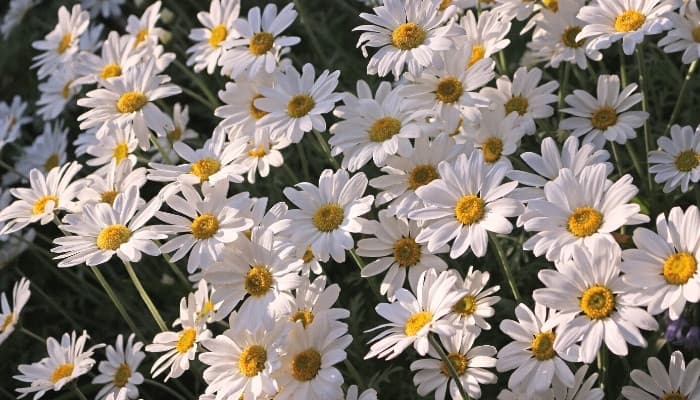
According to folklore, these sweet, iconic flowers possessed magic powers and signified new love and innocence, which is thought to explain why nervous maidens throughout Europe practiced love divination chanting “He loves me/loves me not.”
Use a support stake to help leggier varieties stay upright, and try to divide your daisies every 2-3 years to promote improved flowering.
- Botanical Name: Bellis perennis
- Meaning: Innocence
- Common Colors: White, pink, blue
- Popular Varieties: ‘Blue Marguerite’, English daisy
- Best for Growing Zones: 5-8
- Light Requirements: 6-8 hours full sun
#20. Chrysanthemums
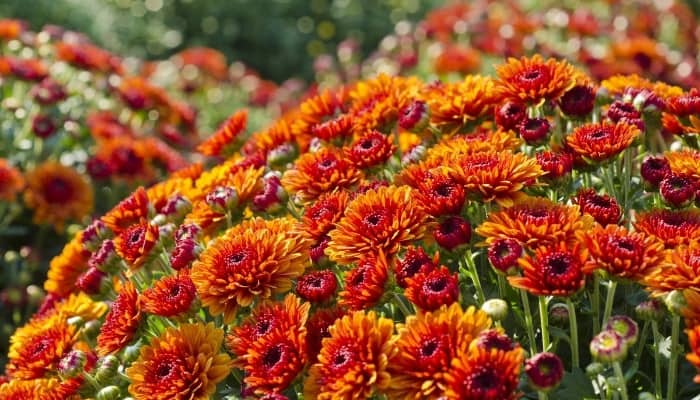
The name chrysanthemum literally translate as “golden flower” in Ancient Greek.
Chrysanthemums have historically represented joy and rebirth – particularly in Japanese culture since they hold a sacred “Festival of Happiness” every year in the flower’s honor.
Reduce weeds near your chrysanthemums by adding a thick layer of mulch to the soil. This will also help lock in moisture.
- Botanical Name: Chrysanthemum spp.
- Meaning: Joy
- Common Colors: Pink, orange, purple
- Popular Varieties: ‘Moonbeam’, ‘Chiffon’
- Best for Growing Zones: 5-9
- Light Requirements: 6 hours full sun
#21. Rosemary
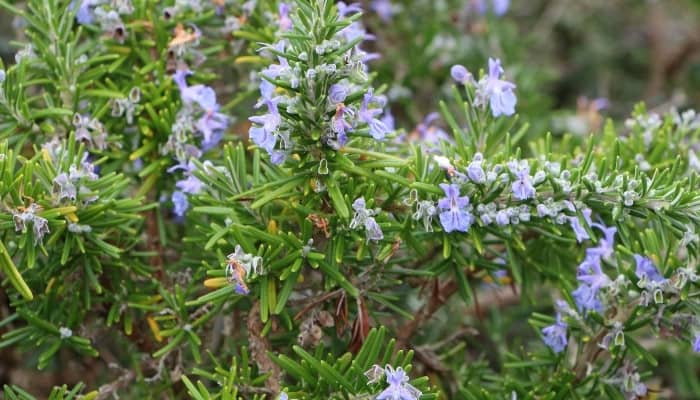
La Source Parfume in Gourdon is famed for its woody-scented rosemary variety, which is adored by perfumers and culinary artists.
Historically, dried sprigs of rosemary were used to embalm the dead in medieval France, leading them to represent remembrance and memory.
These grow best in containers, preferably with polystyrene peanuts added to the bottom to improve drainage.
- Botanical Name: Salvia rosmarinus
- Meaning: Remembrance
- Common Colors: Blue, purple, white
- Popular Varieties: ‘Lady in White’, ‘Benenden Blue’
- Best for Growing Zones: 8-10
- Light Requirements: 6 hours full sun
#22. Cacti

The Cours Saleya flower market in Nice is home to stunning varieties of cacti bearing rose-pink blooms among the thorns, and best of all – they need very little maintenance!
In Native American culture, the gift of a cacti plant represents protection and motherly love due to their strength in the harshest conditions, while the art of Feng Shui believes a terrace placement will banish negative energy from your home.
- Botanical Name: Cactaceae
- Meaning: Protection
- Common Colors: Green, gray, pink
- Popular Varieties: Rosy pincushion, claret cup
- Best for Growing Zones: 6-9
- Light Requirements: 10-12 hours full sun
#23. Poinsettias
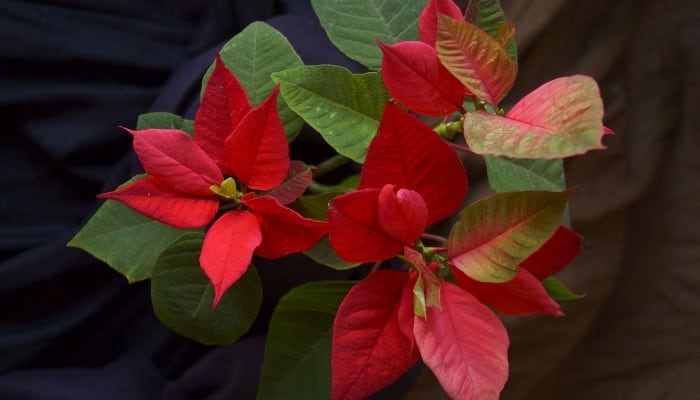
Synonymous with Christmas décor, poinsettia flowers were originally cultivated by the Aztecs who created red dye out of the flower bracts for their bright clothing.
They also saw it as a symbol of peace which led to its modern western meaning of goodwill.
Poinsettias can be enjoyed year-round when potted indoors over winter and given a monthly feed of low-nitrogen, high-potassium fertilizer.
- Botanical Name: Euphorbia pulcherrima
- Meaning: Peace
- Common Colors:Red, cream, pink
- Popular Varieties: ‘Carousel Red’, ‘Enduring Marble’
- Best for Growing Zones: 9-12
- Light Requirements: 6-8 hours dappled sunlight
#24. Orchids
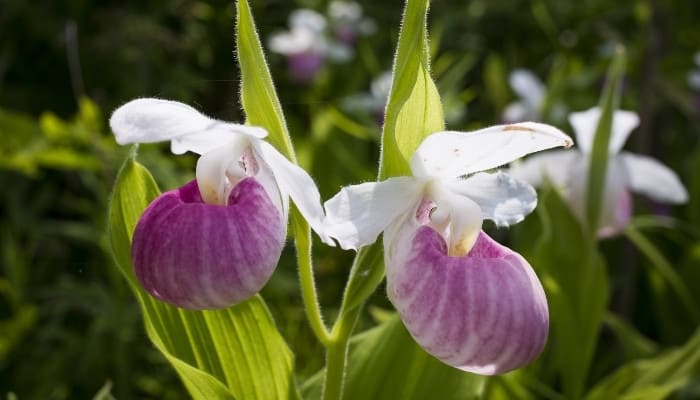
Depending on their color, orchids denote various meanings from sensuality (pink) to eternal hope (blue) and innocence (white).
Parisians can enjoy every color at the Jardin des Plants exhibition that celebrates over 1,000 orchid varieties!
Garden orchids will perform better in lighter, sand-based soil and should be fertilized sparingly due to the damaging salts.
- Botanical Name: Orchidaceae
- Meaning: Hope and sensuality
- Common Colors: Blue, white, purple
- Popular Varieties: Vanda, Brassia
- Best for Growing Zones: 6-9
- Light Requirements: 6-8 hours full sun
Conclusion
To sum up, these sensational French flowers can be home-grown with minimal fuss and will prosper when given the space and ideal soil medium to ensure weeds and moisture-induced rot won’t deter them.
Keep blooms looking très jolie by pruning dying flowers so new growth gets the lion’s share of nutrients!

